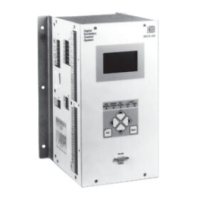DECS-200 Functional Description 3-5
supply provides +5 Vdc, ±12 Vdc, and +24 Vdc for the DECS-200 internal circuitry. When dual power
sources are used, an isolation transformer is required for the ac input.
Analog-to-Digital Converter (ADC)
All analog input signals are brought to the input of the 12-bit ADC. Each input signal is sampled at a rate
that is controlled by the digital signal processor (DSP).
Microprocessor
The microprocessor is the heart of the DECS-200 and performs control, computation, self testing, and
communication functions. The main processor (labeled microprocessor in Figure 3-1) generally performs
low speed tasks such as protective functions, frequency measurements, communication, watchdog alarm,
and other system functions. The microprocessor generates the PWM (pulse width modulated) control
signal needed for chopper control and monitors its status.
Digital Signal Processor (DSP)
The DSP supports measurement, control (output and converters), metering functions and filtering. It
controls both the ADC and the digital-to-analog converter (DAC). All eight analog input signals from the
ADC are filtered by the finite impulse response (FIR) filters. AC signals are also filtered by the infinite
impulse response (IIR) filters and dc signals (field voltage and current) are filtered by averaging filters.
The DSP provides the microprocessor with the signal defining the chopper duty cycle/PWM control.
Operational Settings
Operational settings that affect the system are stored in nonvolatile memory. These settings may be
changed through BESTCOMS or the front panel interface. Password access is required to change
settings. Settings may be viewed without obtaining password access.
Watchdog Timer
If the microprocessor fails for any reason, output pulses to the watchdog timer stop and, after a brief
interval, the watchdog timer takes the system off line and closes the watchdog output contacts.
Real-Time Clock
The real-time clock is used by the event and data logging functions to timestamp events. Time can be
displayed in either 12- or 24-hour formats and can be selected to allow for daylight saving time. Two date
formats are available: d-m-y or m/d/y. All formats may be selected either through the front panel HMI or
BESTCOMS. Any cycling of power to the DECS-200 will reset the clock.
Pulse-Width Modulated (PWM) Output
The pulse-width modulated signal provided by the microprocessor controls the field voltage by modulating
the duty cycle of the chopper (power module).
Relay Output Circuits
There are five output relays. These relay outputs are controlled by the microprocessor and sustain seven
amperes at 240 Vac. Each output relay has 300 volt surge protectors across the contacts to protect
against arcing from inductive loads. Relay outputs one through three are fully programmable via all
interfaces. Two output relays (one form A and one form B) have predetermined functions. All output
relays are described in the following paragraphs.
Programmable Outputs
Output relays RLY1, RLY2, and RLY3 may be programmed using the front panel HMI, BESTCOMS
software (using the front RS-232 port (COM0)) or through the Modbus™ protocol (using the left RS-485
port (COM2)).
The three output relays labeled RLY1, RLY2, and RLY3 have the following programmable features.
• Selection of contact functionality (normally open or normally closed)
• Selection of output type (momentary, maintained for as long as the condition is present, or latched
until reset)
• Program duration of momentary annunciation (from 0.1 to 5 seconds in 50 millisecond steps)
• Selection of conditions to be annunciated, including:

